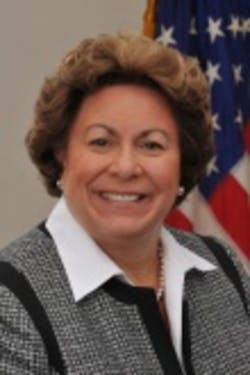Exclusive Interview: ONC’s Judy Murphy Talks about Meaningful Use Stages 2 and 3—and the Power of the Patient
Senior officials from the Centers for Medicare & Medicaid Services (CMS) and from the Office of the National Coordinator for Health IT (ONC) had a higher-profile presence at the HIMSS Conference this year (held last month at the Ernest N. Morial Convention Center in New Orleans) than ever before. Along with CMS Acting Administrator Marilyn Tavenner, R.N., and National Coordinator for Health IT Farzad Mostashari, M.D., Judy Murphy, R.N., Deputy National Coordinator for Programs & Policy at ONC, spoke to HIMSS13 attendees in a scheduled appearance, and also met with groups of attendees in a variety of settings. The appearances of all those federal healthcare officials reflected a more high-profile presence than in the past, along with important announcements, such as the release of a self-described “aggressive” agenda” for healthcare IT in 2013 on the part of CMS and ONC.
In the wake of HIMSS13, Murphy spoke with HCI Editor-in-Chief Mark Hagland regarding her perspectives on the HIMSS Conference, Stages 2 and 3 of meaningful use, and what she’s most passionate about these days in her work. Below are excerpts from that interview.
What was your experience of HIMSS this year?
We had a little debrief at ONC afterwards, and I think we were pretty much in consensus that it felt different. And the ‘different’ part of it was pretty much around the idea of ‘frenzy,’ both among providers and vendors in the past, whereas, this time, it felt more like a digging down into the practical elements; it was just different from the previous feeling. Perhaps it was a maturity, I guess, of the industry, and the lack, really, of panic, and concern over Stage 2. Very different from last year, even.
You all seemed to put forward a tone of confidence and engagement this year at HIMSS, while maintaining your clarity on the core requirements that the industry is facing. I know you probably won’t like the word “cheerleading,” but how about persuasion? It seems that now is definitely a time where everyone at ONC realizes that it’s important to provide encouragement for the industry to move forward. Am I reading your tone correctly?
I think you’re reading the tone correctly; however, I would extend it a little bit. I think what I’m focused on, and I think it extends to David [Muntz, principal deputy national coordinator] and Farzad [Mostashari, M.D., national coordinator for health IT] in the same way, though we haven’t specifically had this conversation, and that is, making it real. I’ve lived it; and I think we can say, think of it this way, or build it that way. So the interoperability modules; the Steve Posnack videotape going through the numerators and denominators; we didn’t have those tools in Stage 1. For the longest time, the implementation workgroup was talking about harmonizing the criteria themselves with the standards. And that ended up being integrated into a grid that Steve Posnack and his team created. But we’re trying now to give everyone tools, as opposed to making every patient care organization figure it out for themselves. I don’t like that word ‘cheerleading’; but I do like the word ‘persuasion.’ So it’s persuasion, coupled with some very pragmatic tools and programs. That having been said, we’re in a different place than we were at the beginning of Stage 1.
Judy Murphy, R.N.
It seems that there’s just more acceptance overall that meaningful use is happening, and it’s time to get moving, too, right?
Yes. I remember people saying at the beginning of Stage 1, ‘They’re not really going to pay us.’ And I was like, really? And then hearing the delight in people’s voices when they did get paid. At Aurora [the Milwaukee-based Aurora Health Care, where Murphy worked from 1995 through 2011, most recently as vice president of EHR applications], I think it was after 30 days. Now, there were some issues with Medicaid, but certainly for the Medicare reimbursements, things moved quickly.
I’ve talked with some industry experts who were particularly intrigued at the requirement under Stage 2 for LOINC-based lab values, which was underscored in documents made available during the HIMSS Conference.
If we’re going to have interoperability, we need standards based on vocabulary, packaging, and transport. And LOINC is vocabulary-related, per labs. And if we’re going to finish our journey of interoperability here, it’s going to be particularly important that if you send something, it can populate the EHR. And the only way to do that is to know that a hemoglobin is a hemoglobin, and the only way to do that is via LOINC. That requirement wasn’t new as of HIMSS13, though.
I know; I guess sometimes you do things at ONC, and people don’t even realize it at first.
Yes, sometimes we shine a spotlight on something, and people realize for the first time that it’s in the mix. We had Sunquest Lab at Aurora, and we could have chosen to use LOINC, but we didn’t, because we had built our application when they didn’t have LOINC. Now it has to be LOINC.
Is there anything that you can hint about, regarding the Stage 3 requirements?
The answer is, ONC doesn’t know what Stage 3 is going to be, because we very strongly take the counsel of the Meaningful Use Workgroup and the HIT Policy Committee; and they’ve only put out an RFI and begun getting comments back. And so until they cohese those comments, we’re not holing up and doing any separate activity. And we really do need to stay focused on implementing Stage 2, and take the pressure off a little bit on Stage 3.
Will the delay impinge on giving providers enough time to meet the requirements for Stage 3?
All I can say about that is that you’ve probably answered your own question.
Do you think we’re moving fast enough on the physician acceptance side? Are physicians really moving forward as quickly as you’d like them to, to adopt and indeed, to embrace EHRs?
It is an interesting question, because it involves a bell curve like everything else. I think what’s happening is that the whole curve is moving to the right. So yes, there are a lot more people adopting and using EHRs. Now, are they more accepting? Some yes; some are sensing the inevitably of it all, and are becoming users because they know it’s inevitable, as opposed to really wanting it and accepting it. I think the average physician thinks the products are not good enough; but also that the products aren’t going to get better without use.
Will the vendors listen to the doctors’ legitimate complaints? My personal physician shared with me in my most recent office visit some of his frustrations with workflow and documentation issues within his organization’s EHR, which is from one of the industry-leading vendors. He legitimately finds some elements very user-unfriendly.
That’s not uncommon, with regard to all vendors. Sometimes, it has to do with the innate capabilities of the software; and sometimes, it has to do with the configuration. I remember seeing some extremely illogical things with Epic when we were implementing it at Aurora, and I knew it wasn’t the way we had designed things. It had to do with role-based workflow, and with the IT security elements we then imposed on the system. These are very, very complicated software packages. What I can say is, that’s what we have to keep working on. And what makes sense in a lab [testing] setting, doesn’t always make sense in the real world.
Do you think that EHRs will really be much more user-friendly, much more physician-friendly, in a few years?
I think so. It’s like anything. Look at the way the airline websites first worked; they weren’t that user-friendly. And with healthcare IT, we’re not yet at the point of the cycle where things have been vetted enough. But that will come soon.
Finally, is there anything you’d particularly like to share with our audience, through this conversation?
The area that I’m most passionate about now that I think is really going to make a difference is the power of the patient—patient engagement in their health, shared decision-making in health and healthcare, engaging the patient really as a full partner, both in health and wellness activities and in disease management. I think it’s going to make a huge difference. And we’re going to have to have greater interoperability, because patients are going to demand it when they get engaged. It’s going to be a driving force in the industry.
And won’t the PHR [personal health record] be part of that patient engagement?
Oh, definitely. And there’s a difference between a portal and a PHR, where the patient controls it. And this is part of that empowerment idea. But it requires a real culture change.
I think it involves societal shifts involving how clinicians, physicians in particular, interact with their patients, and how patients view their role in patient care.
Yes, and layer on top of it your access to both your personal healthcare information and to healthcare and health information in general.
With generational change, too, people who are younger now are demanding a different type of physician-patient relationship. Ultimately, the physician is becoming an advisor and counselor to the patient, not some god on a throne.
And a coach, too, absolutely.



